7 Best Dip Variations (with Pictures!)
The dip is as effective a push exercise as it is impressive to watch.
Like many other traditionally bodyweight exercises, numerous progressions and variations of the dip have been developed over the years. This can make pinning down the right one difficult for first-time workout planners.
At the beginning of your training career, the assisted and conventional dip are all you need. More advanced variations like the Korean dip or planche dip are better left for when you’ve truly mastered proper dip mechanics.
What is a Dip?
A dip is an upper body compound movement primarily performed so as to train the push muscles. It is traditionally performed with only bodyweight resistance and a pair of suspended bars, but can also be weighted if needed.
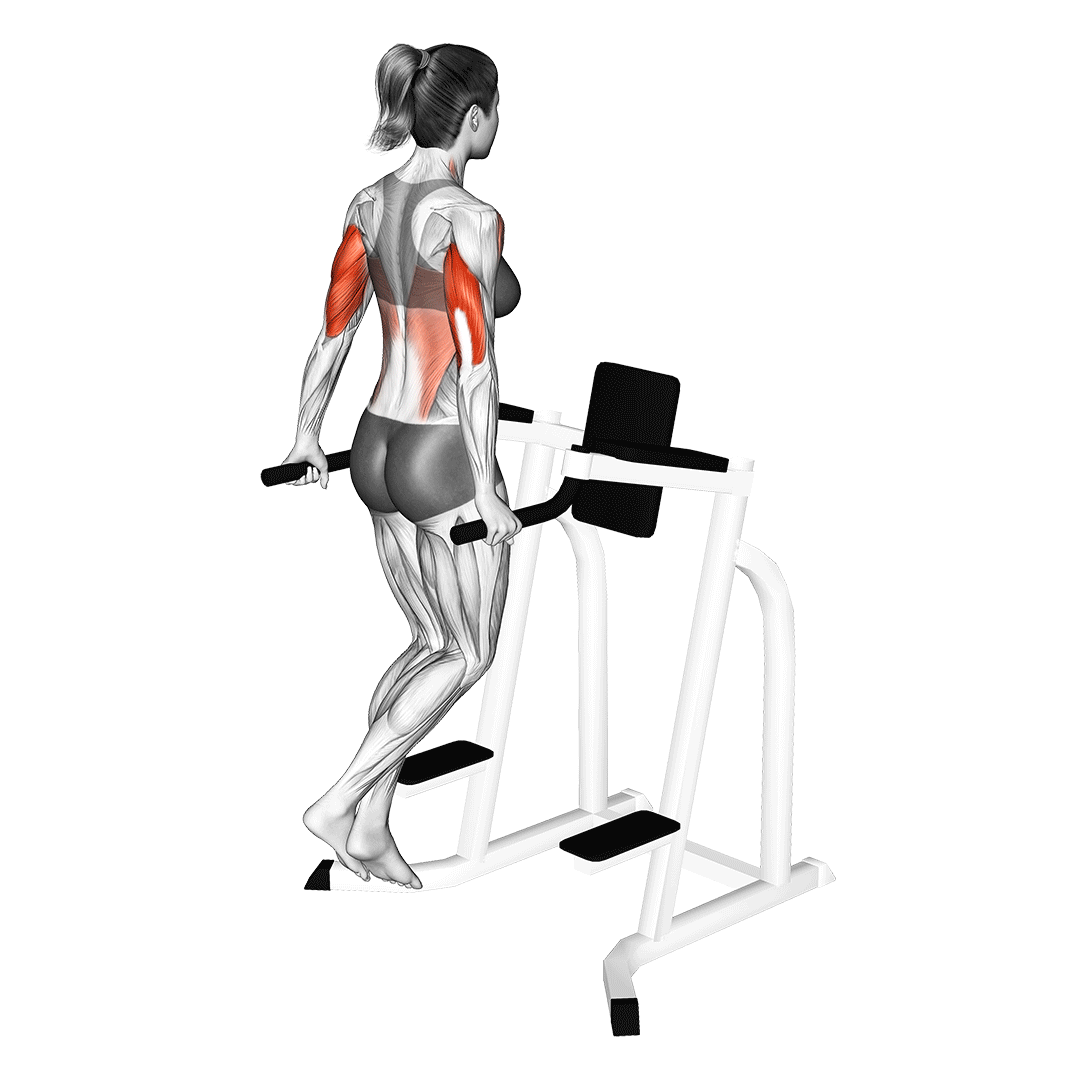
Dips are considered to be a more advanced counterpart to the push-up in bodyweight training disciplines. Generally, they will require the lifter to have an already-established level of upper body strength in order to perform them correctly.
The majority of dip variations simply change the position of the hands and arms in relation to the body. This alters what sort of muscles are emphasized by the exercise.
Dip Variations
1. The Conventional Dip
The conventional dip (AKA the dip bar dip) is the quintessential form of dip, requiring the lifter to suspend themselves between a set of parallel bars as they “dip” their body downwards.
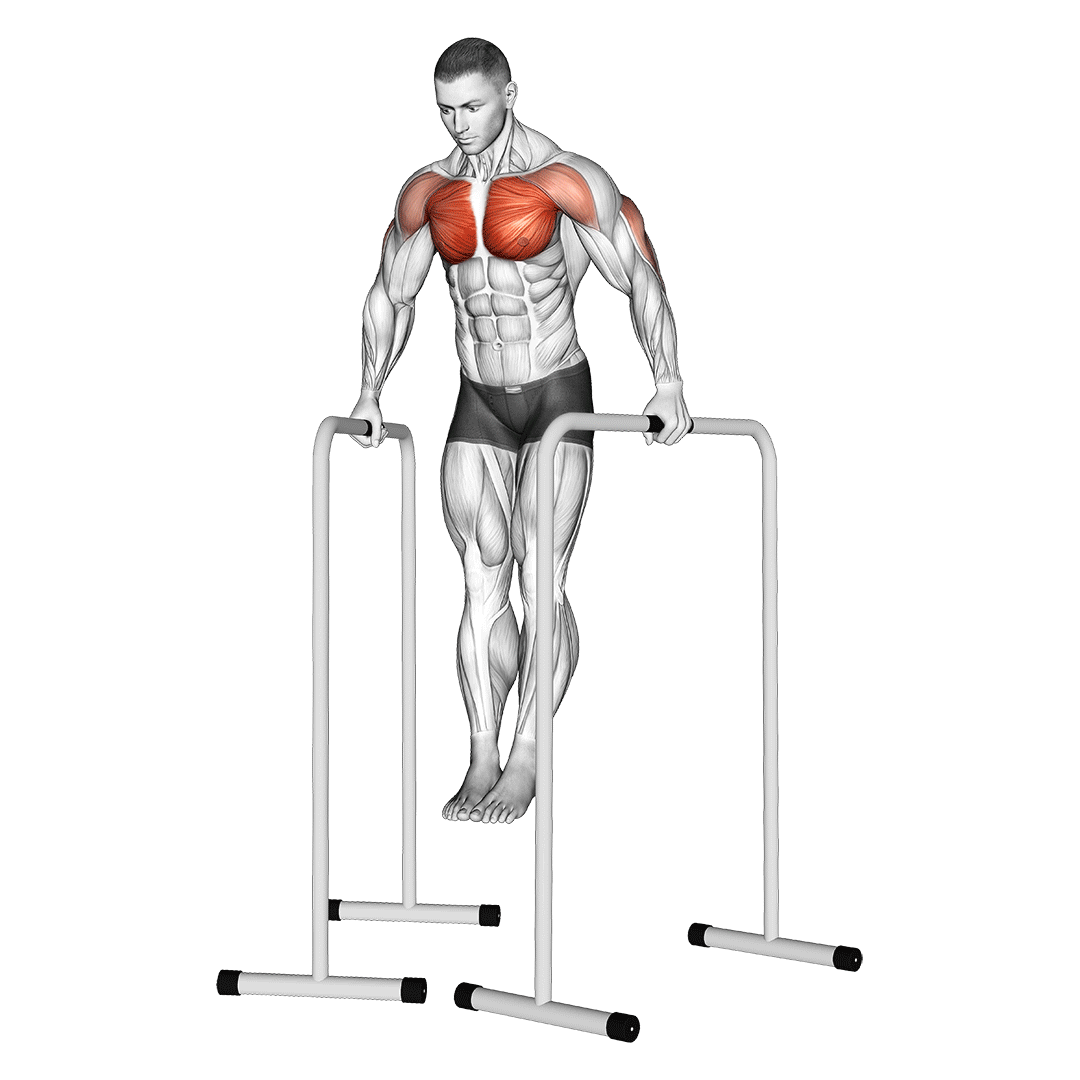
As will be the case with all other dip variations, the conventional chest dip is a multi-joint compound exercise performed so as to target the muscles of the chest, arms and shoulders.
Equipment Needed
Conventional dips traditionally only require a pair of parallel bars. However, they can be made more challenging with the addition of wearable weights, a dip belt or a resistance band.
Muscles Worked
The conventional dip will work the pectorals, triceps brachii and deltoids to a moderately intense fashion. In addition, the core is also recruited isometrically.
Benefits as a Dip Variation
The conventional dip is considered to be the baseline dip exercise, and should be the first dip variation a novice masters prior to attempting more complex variations.
As far as dip variants go, the conventional dip is as simple as it gets, and is an all-around effective muscle builder of the upper body.
How-to:
To perform a conventional dip, the lifter will first suspend themselves between a pair of dip bars. The hands should be set just slightly in front of the body, with the elbows loosely extended and the shoulders rotated neutrally.
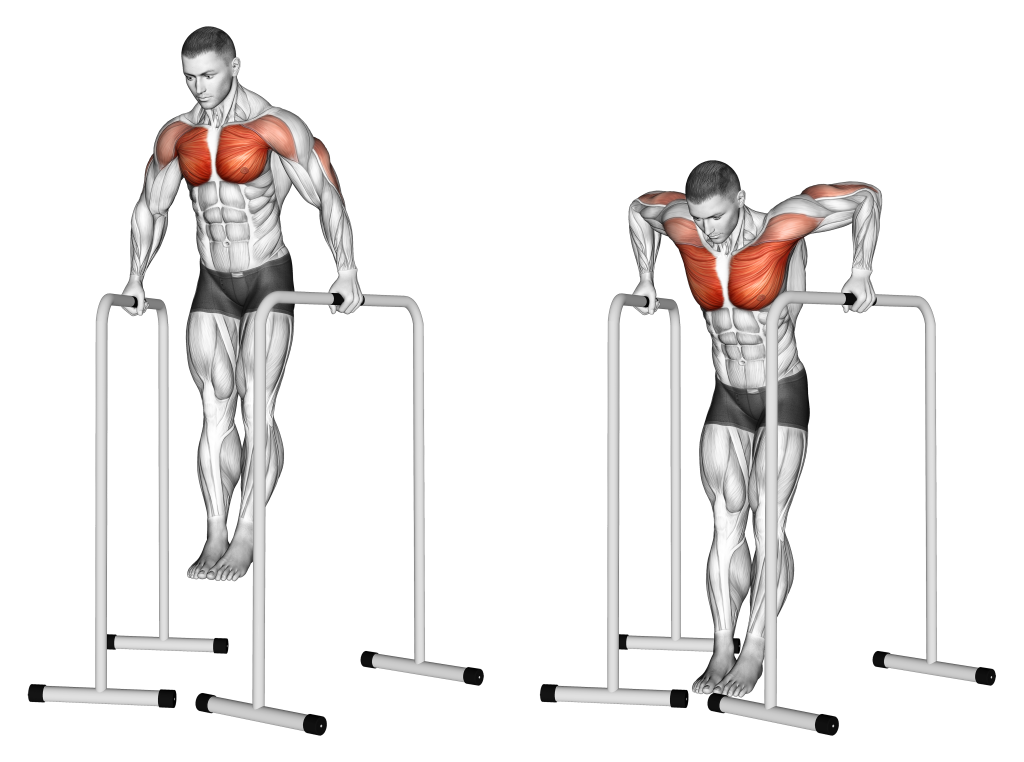
Contracting the core for stability, the lifter then bends at the elbows and slowly lowers their body between the bars, allowing a slight forward tilt of their chest as they do so.
Once the elbow displays at (or less than) a 45 degree angle of flexion, the lifter contracts their chest and triceps and drives through their palms.
The repetition is complete once the arms are extended once more.
2. The Gymnastic Ring Dip
As the name implies, gymnastic ring dips are simply conventional dips performed with the use of gymnastic rings. This allows for a somewhat freer range of motion and general movement pattern, making it less strenuous on the joints when performed correctly.
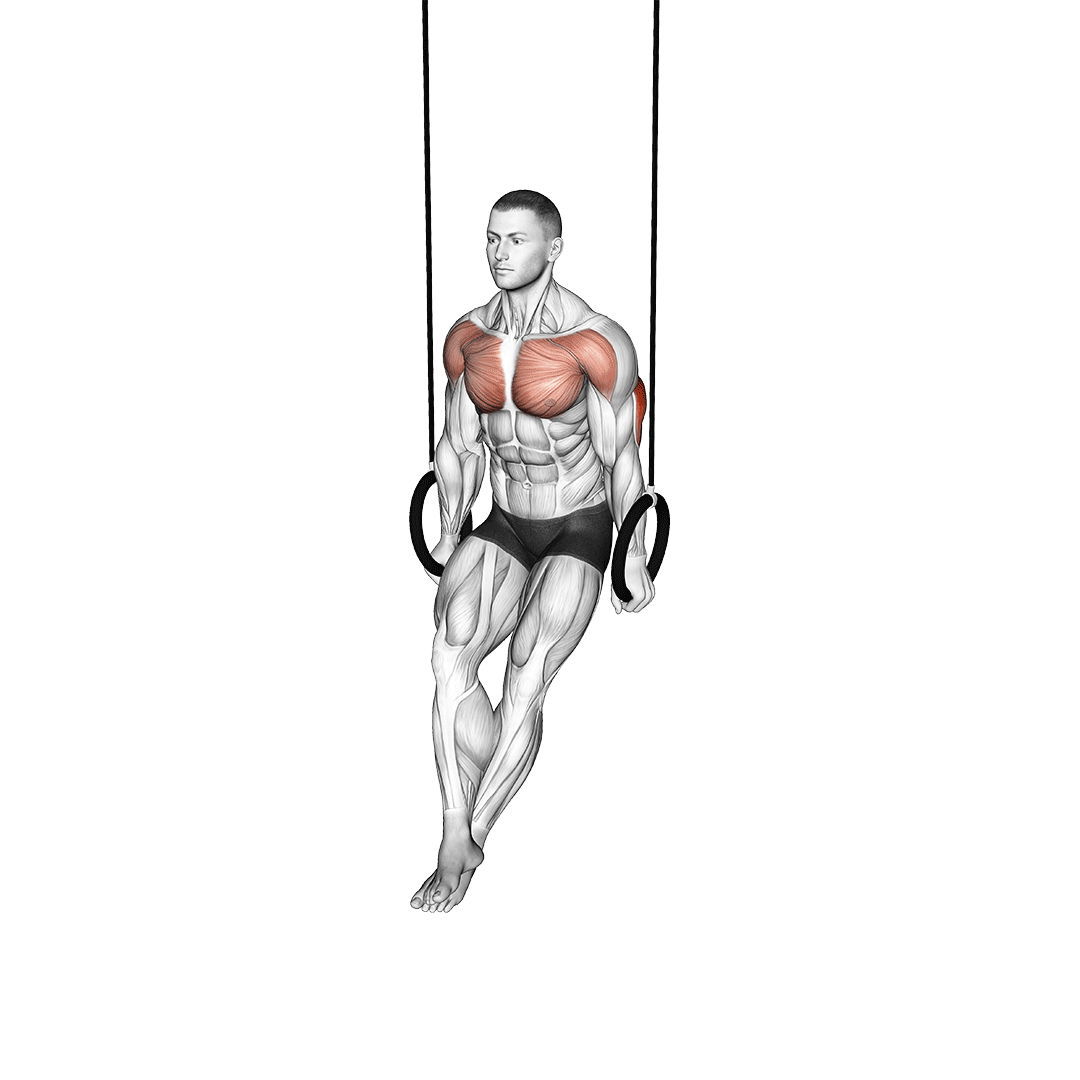
Gymnastic rings may require somewhat greater stability than conventional dip bars, and as such are considered to be a more advanced movement than the standard parallel bar dip.
Equipment Needed
Gymnastic ring dips will require - well, gymnastic rings. Often, a sturdy object or rack will also be needed to affix the rings.
Muscles Worked
Ring dips work the same muscles as conventional dips, meaning the pectorals, triceps and deltoids. In addition, greater isometric contraction of the deltoid muscles will also be elicited.
Benefits as a Dip Variation
Ring dips benefit from a somewhat freer form and lower risk of injury as the shoulders are allowed to rotate in a more advantageous manner. So long as the exercise is performed correctly, it is considerably less stressful on the joints than conventional dips.
How-to:
To perform ring dips, the lifter will grasp the handles in a neutral grip and raise themselves off the floor, extending their arms so as to assume the correct stance.

Once suspended over the floor, the lifter will simply bend at the elbows and lower their chest forwards until the arms are bent at a 90 degree angle. From this point, they will push through their hands and extend their arms back up - thereby completing the repetition.
3. The Bench Dip
The bench dip is primarily used as a more triceps-focused alternative to the conventional dip. Unlike most other dip variations, the bench dip keeps the hands behind the lifter’s torso, and allows them to place their feet on the floor, rather than suspending themselves in the air.
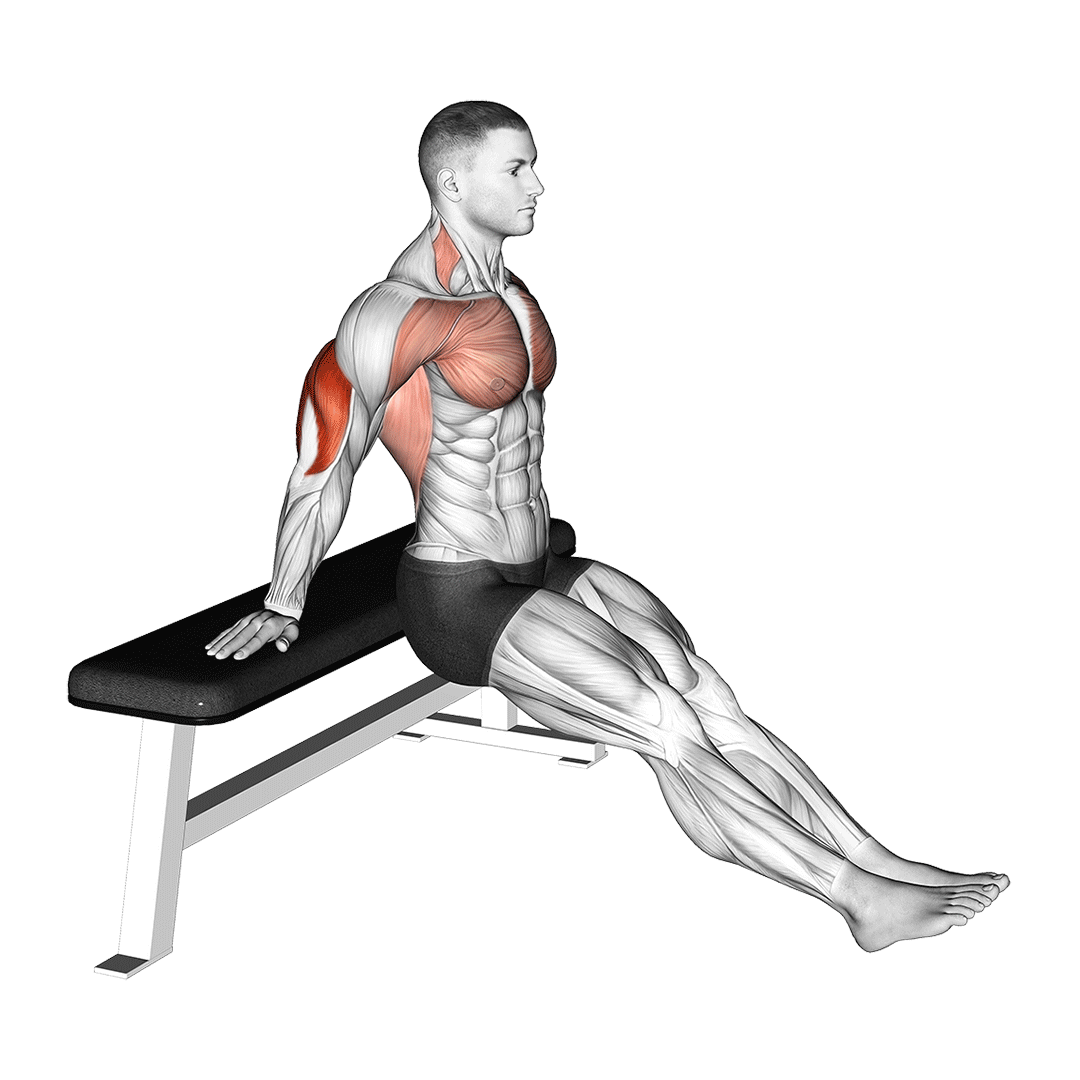
Because of this shift towards the triceps, the bench dip is more often used as an accessory exercise, rather than as the main dip movement within a workout.
Equipment Needed
Bench dips require an exercise bench, chair or similarly elevated surface.
Muscles Worked
Apart from targeting the triceps, the bench dip will also work the latissimus dorsi and pectoral muscles to a lesser extent as well.
Benefits as a Dip Variation
Bench dips are an excellent way of building triceps mass and strength without the need for actual exercise equipment. Conversely, the exercise can also be loaded by placing a weighted object atop the legs so as to work the triceps even more.
How-to:
To perform a repetition of bench dips, the lifter will sit facing away from an exercise bench, placing their hands atop it and keeping the arms close to the sides of the torso. The legs should be extended forwards with the heels touching the ground.
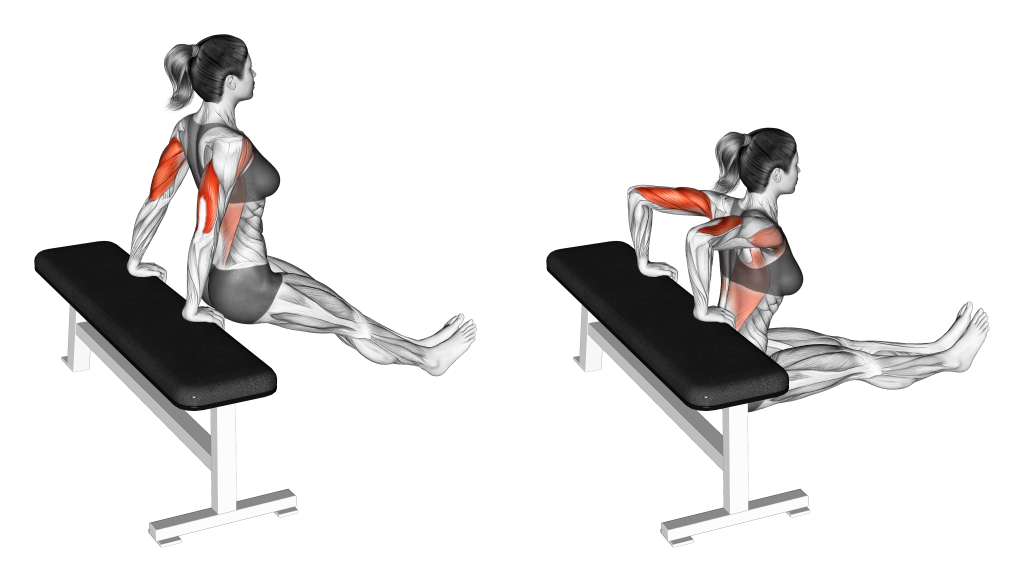
Keeping the chest pushed out and the elbows pointing back, the lifter will bend their arms and lower themselves without involving their legs.
When their upper arms are above parallel with the floor, the lifter drives through their palms and extends the arms once again - returning to the starting position and completing the repetition.
4. The Straight Bar Dip
The straight bar dip is simply a dip performed with the use of a single straight bar, placing the hands in a pronated orientation and creating greater emphasis on the chest and deltoids.

Straight bar dips follow much the same thought and mechanics as conventional dips, but are occasionally the subject of controversy due to the inherently greater strain placed on the wrist joints.
To combat this, some calisthenics athletes prefer to perform the exercise with a pair of slightly angled bars instead.
Equipment Needed
Straight bar dips will require a pull-up bar, a racked barbell or any type of similar object.
Muscles Worked
Straight bar dips primarily target the pectoral muscles and the deltoids, but will also work the triceps brachii.
Benefits as a Dip Variation
The straight bar dip is most often used as a progression step to the muscle-up, as it features a similar movement pattern.
Apart from acting as a progression exercise, straight bar dips are also comparatively better at working the pectoral muscles than the conventional dip - especially if the hands are set close together.
How-to:
To perform a straight bar dip, the lifter will begin by suspending themselves over a straight bar, hands set around shoulder-width apart.
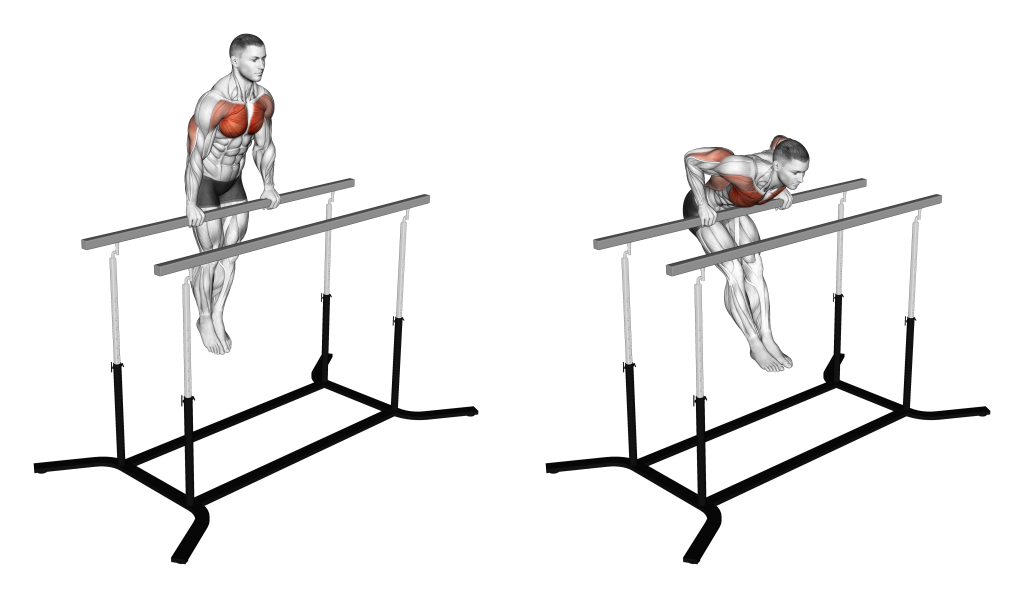
Leaning forwards at the waist, the lifter then bends at their elbows until their chest is within several inches of touching the bar.
From this position, they will squeeze their pectoral muscles and extend their arms once more - returning to an upright position and completing the repetition.
5. The Assisted Dip
Assisted dips are machine-assisted conventional dips primarily performed by individuals who cannot perform the exercise on their own. While the dip assistance machine is the most common form of assisted dip, it is also possible to use resistance bands or even other people.
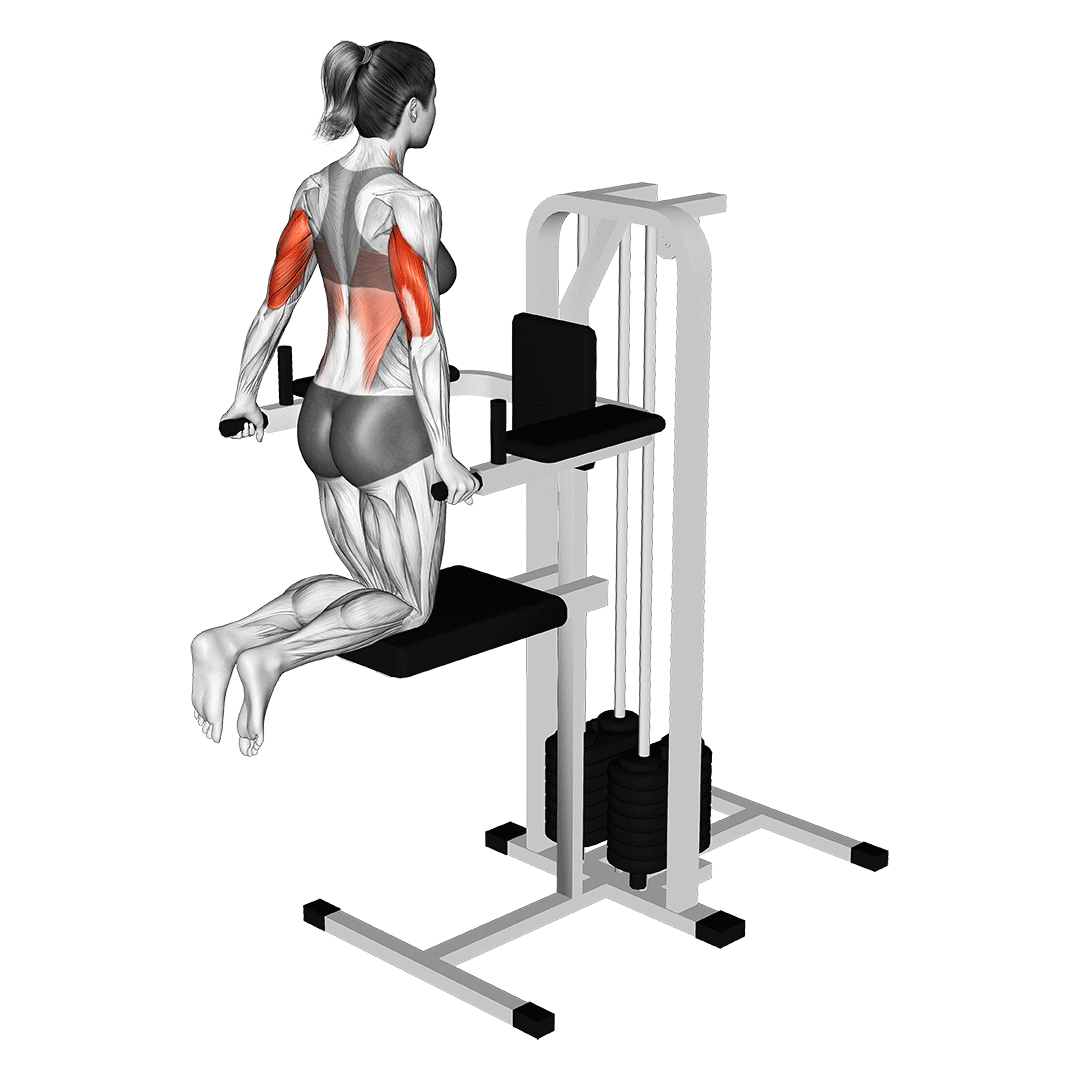
It is best to avoid overly-relying on the usage of assisted dips. Instead, lifters should see it as more of a temporary exercise that allows them to build the necessary strength to perform unassisted dips.
Equipment Needed
As touched upon, the assisted dip is most often performed using an assisted dip machine. However, it is also possible to use resistance bands instead,
Muscles Worked
The assisted dip replicates the stance and mechanics of a conventional dip. This means that it works the same muscle groups - those being the pectorals, deltoids and triceps.
Benefits as a Dip Variation
The main benefit of doing the assisted dip is its capacity to act as an introductory exercise to dips in general. However, this is not its only purpose, as it can also be used to maximize training volume once fatigue prevents the lifter from performing conventional dips.
How-to:
To perform assisted dips, the lifter will simply place their knees atop the machine’s pad, setting the counter-resistance as low as possible.
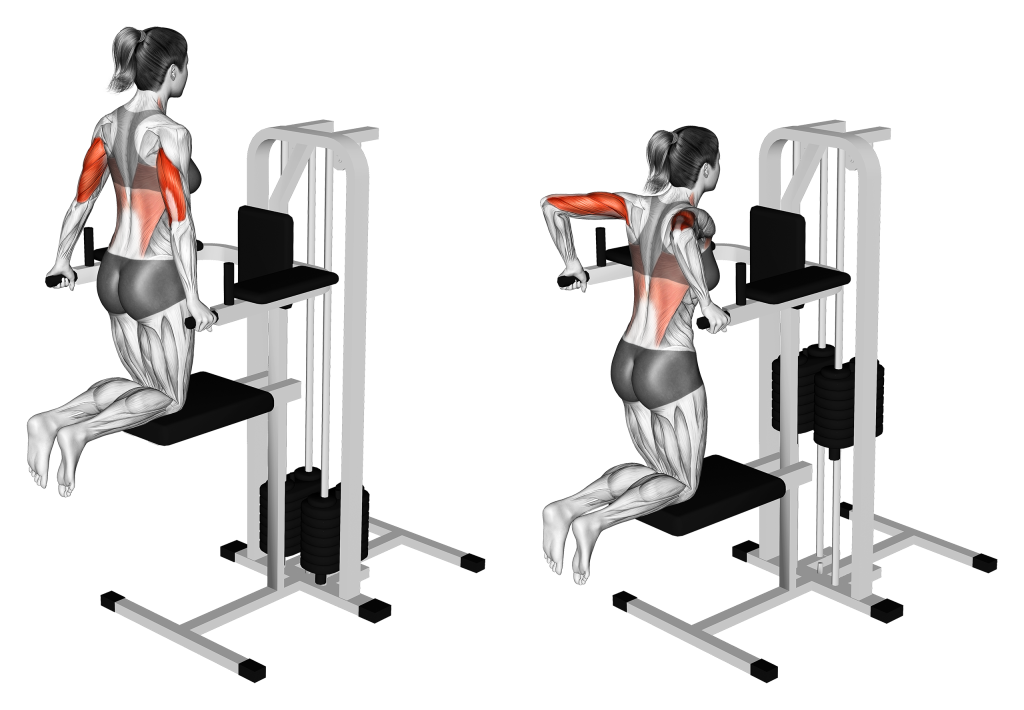
Once they are situated atop the pad, the lifter then places their hands along the parallel bars at their sides and allows their weight to push the machine’s pad downwards.
When their upper arms are bent at a 90 degree angle, the lifter then pushes through their palms and rises back up with the assistance of the machine.
This completes the repetition.
6. The Korean Dip
Korean dips are a highly advanced variation of the straight bar dip, involving the lifter facing away from the bar and lowering themselves beneath it until their legs can curl around.
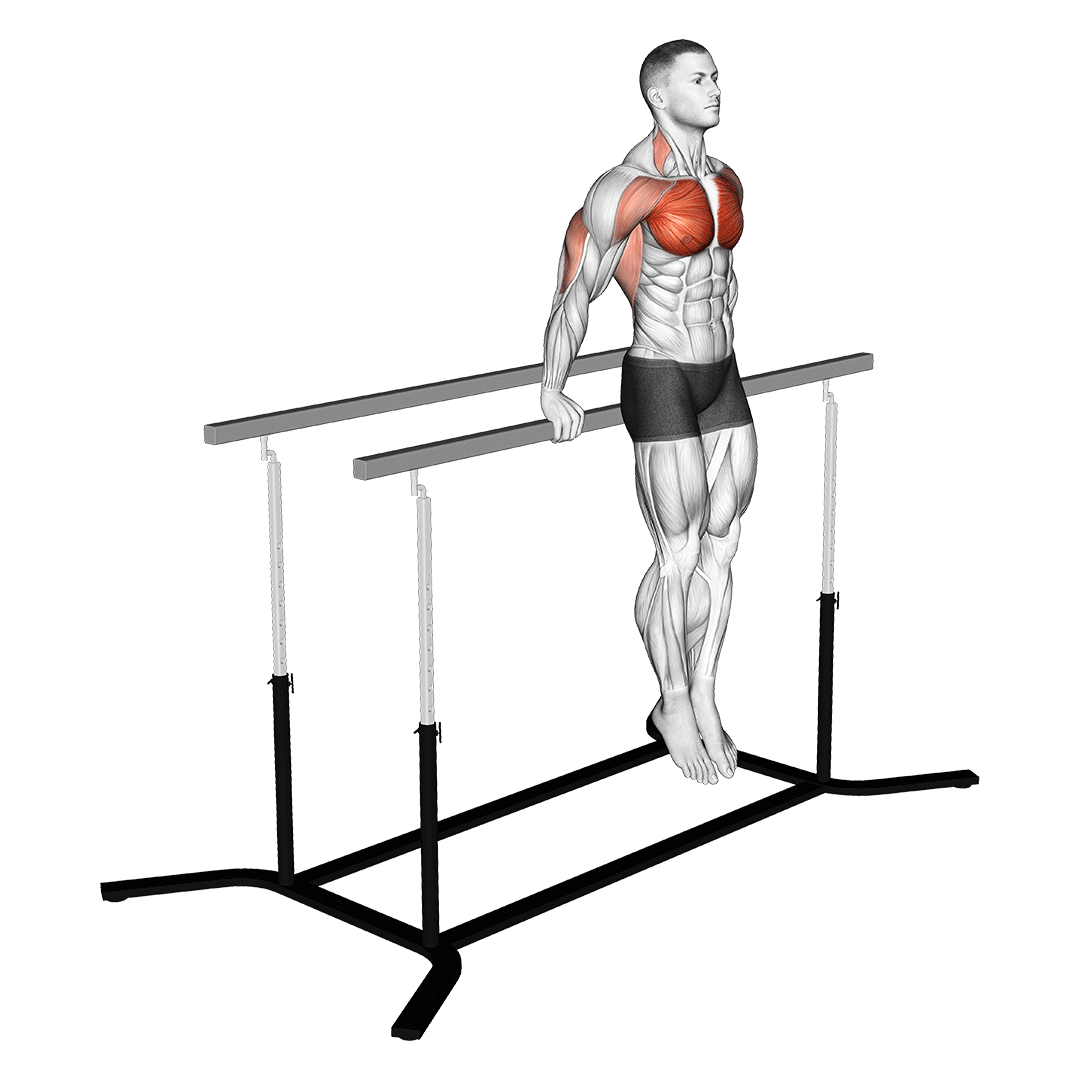
Because of how advanced and risky this exercise is, it is rarely used in actual training and is more often seen as a show of strength during competition.
Nonetheless, the Korean dip is still a very effective exercise that will target the muscles of the back alongside the usual chest, shoulders and triceps.
Equipment Needed
Korean dips will require a straight barbell.
Muscles Worked
Korean dips target the pectorals and triceps the most, but will also work the entirety of the deltoids, the latissimus dorsi and the trapezius.
Benefits as a Dip Variation
Korean dips are highly effective at working both sides of the body to an extremely intense level. Risk of shoulder injury notwithstanding, it can be useful for truly maximizing how much development is possible with bodyweight resistance alone.
How-to:
To perform a Korean dip, the lifter will suspend themselves from a straight bar as they face away from it ,their hands wider than shoulder-width apart behind them.
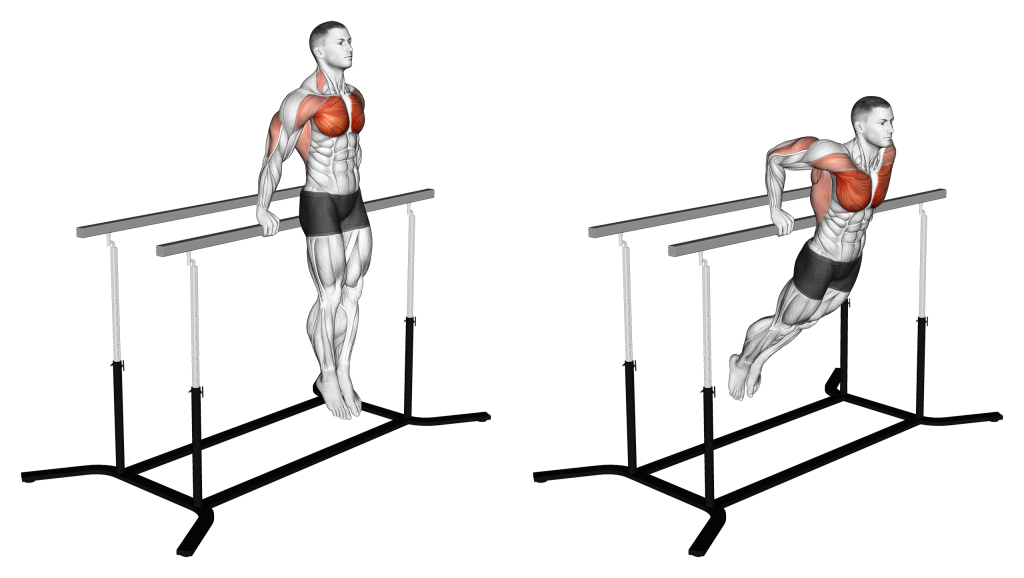
Dipping down by bending at the elbows, the lifter will then push their chest forwards while at depth, extending their legs beneath the bar as if attempting to lie under it.
Once the elbows are bent at a 90 degree angle, the lifter then extends their arms and draws their legs back beneath their torso - thereby completing the repetition.
7. The Planche Dip
Planche dips are yet another advanced dip variation - this time requiring significant core strength and shoulder stability.
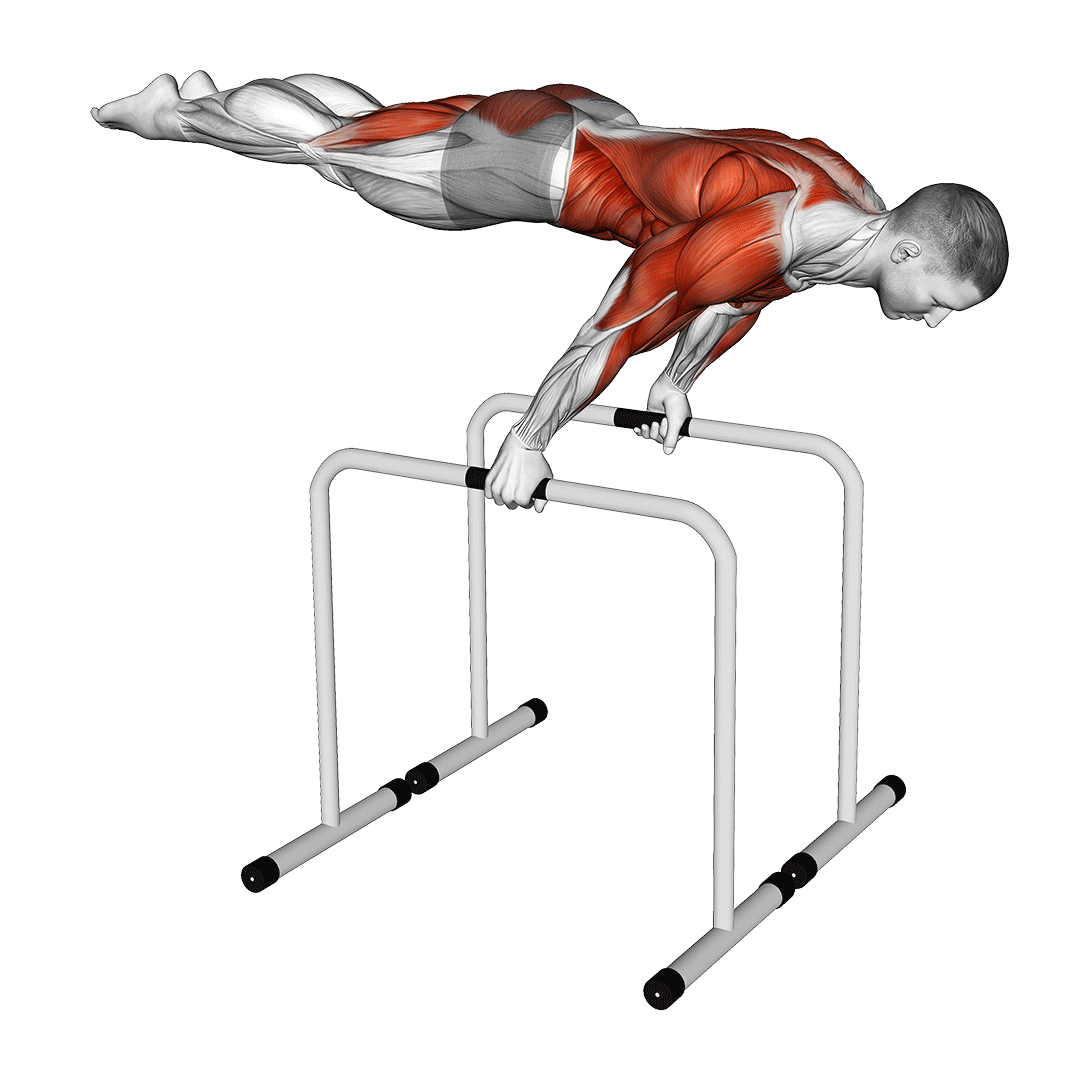
Planche dips involve the lifter suspending themselves between a set of parallel bars and utilizing their abdominal strength to place themselves in a horizontal orientation. Once oriented in this way, they will proceed to perform a dip, remaining horizontal the entire time.
Equipment Needed
Planche dips require parallel bars or gymnastic rings.
Muscles Worked
Planche dips truly excel at targeting the pectoral and tricep muscles, and will also double as an intense abdominal exercise as well.
Benefits as a Dip Variation
The planche dip is both an upper body push exercise and a static hold meant to target the abs. This, combined with the greater tension from being in a horizontal position, equates to a far more intense dip variation as a whole.
How-to:
To perform a planche dip, the lifter begins by first suspending themselves between a set of parallel bars. The hands should be set slightly behind the body, and the shoulders in a neutral rotation.
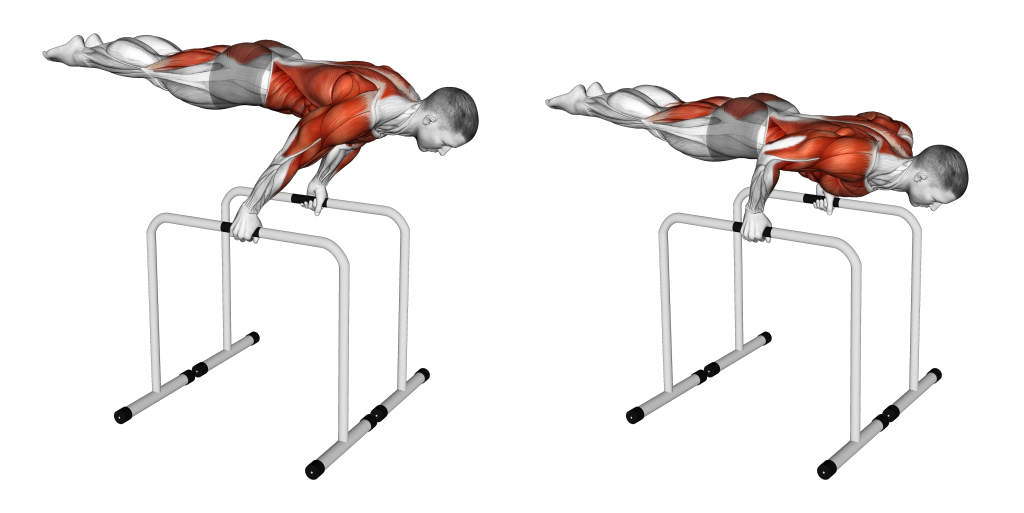
Then, the lifter performs a planche by contracting their core and leaning their torso forwards as they simultaneously extend their legs behind them. All the while, their arms should be loosely extended over the bars.
Now in a planche stance, the lifter will bend at the elbows and lower themselves until their body is beneath the parallel bars. From this position, they will then squeeze their triceps and extend their arms once more - raising themselves upwards and thereby completing the repetition.
How to Pick the Right Dip Variation
Picking the right dip is as simple as picking the correct one for your current skill level.
If you’re new to calisthenics or just coming back from an injury, try the assisted dip. From there, work your way up to more advanced variations - or try adding weight to the conventional dip.
Remember that it can also be beneficial to perform more than one kind of dip within the same session. Combining triceps dips with straight bar dips yields a more comprehensive upper body workout.
References
1. McKenzie A, Crowley-McHattan Z, Meir R, Whitting J, Volschenk W. Bench, Bar, and Ring Dips: Do Kinematics and Muscle Activity Differ? Int J Environ Res Public Health. 2022 Oct 14;19(20):13211. doi: 10.3390/ijerph192013211. PMID: 36293792; PMCID: PMC9603242.
2. Kalym, Ashley. Complete Calisthenics, Second Edition: The Ultimate Guide to Bodyweight Exercise. United States: North Atlantic Books, 2019. ISBN: 9781623174125, 1623174120
